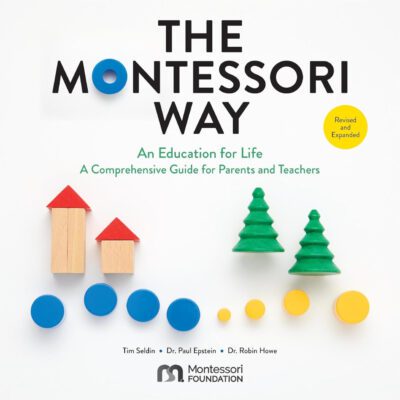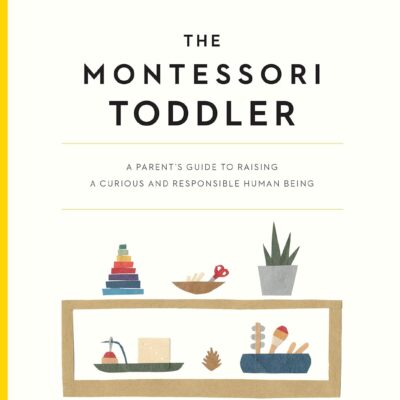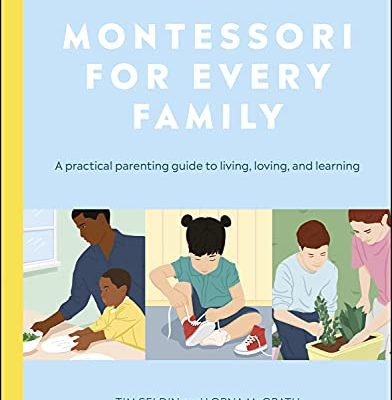The Montessori School Blueprint Model
Introduction
Montessori schools are different – profoundly different – from the familiar traditional classrooms that most of us attended in our childhood years.
Those of us who have spent years around Montessori children know that Montessori works; however, while the average person has heard of Montessori, most know little about it and have conflicting impressions of what Montessori reflects. This is nothing new or unique. It has been the case since Dr. Montessori opened her first school outside Rome in 1907.
Some people rave about Montessori; others think that parents must be nuts to put their children in a Montessori school. Some are firmly convinced that Montessori is too rigid and robs children of their creativity, while others object that it is completely unstructured and without any academic standards.
“Isn’t Montessori the sort of school where they allow the children to do and learn whatever they want, whenever they want? Perhaps it will work for your little Sally, but I’m afraid that if my Danny were left to his own devices, he’d never choose to do a lick of schoolwork! He needs order, structure, a small class size, and discipline!”
Over more than thirty years leading two wonderful Montessori schools, I tried to help parents sort all this out so they could reassure themselves that Montessori is not going to leave their children academically handicapped and unable to make it in the real world. Most of the parents that I’ve known are sympathetic and enthusiastic, but it is still difficult for them to defend their decision to send their children to Montessori when the rest of the world seems so completely committed to a very different approach to raising children.
Having made the decision to take this course through the Center for Montessori Leadership, we hope that you will seriously consider the possibility of leading your school through this process of extensive self-evaluation and improvement. We think of this process as Building a World-Class Montessori School.
This is a daunting task. For most Montessori schools, taking the step from being a good Montessori school to becoming a great one will require a great deal of work, the investment of a year or longer, and a considerable amount of money. Moreover, once begun, it is very important that you not back off from your commitment to excellence. Your school must be prepared to meet your families’ and staff’s raised expectations, and you must follow through on the commitments that you have made to the school community. This is not something to be undertaken lightly.
You will begin with the process of clarifying your unique character and carefully defining the fundamental values on which your work from this point forward will be based. You will address a host of issues regarding your day-to-day operation and future plans. You need to make several complex decisions about enrollment, administration, and finances; raise capital and endowment funds; and begin to implement major change. And it is quite likely that you will face a host of additional issues that you have yet to identify.
Change is often stressful to a school community but also presents new opportunities for growth.
Like anything new, it is easier to go through the process for the first time if you have a guide who has been there before. While this book cannot do your homework for you, nor avoid the necessity of putting in countless hours of hard work, planning, and decision-making, it should make the nature of your journey more easily understood and may make the process easier for you and your school community.
By our definition, a world-class Montessori school has made an absolute commitment to excellence. The school clearly defines its identity, mission, and core values. The school community has sought out examples of true excellence in Montessori practice around the world and has consciously defined what excellence would look like in every aspect of its programs, facilities, and operations. Plans have been laid for how one might create and maintain this excellence in each area, not by chance, but year after year by deliberate design.
The school has further identified what it would cost to create and sustain excellence in all things and has developed a plan for funding the cost of excellence.
Montessori schools do not become world-class simply by building the right buildings or hiring the right teachers. First and foremost, a school lives in the minds and vision of those who are central to its life. No school can be great without a clear sense of its core values and the culture of the institution: this is who we are and how we do things here. The character of the school will evolve, but it should evolve slowly and in a logical progression of maturation.
Unfortunately, we all know that it is all too easy for a Montessori school to make compromises because of tight budgets, lack of parent understanding and support, or because Montessori-trained teachers are hard to find.
We all know the story of the Emperor’s New Clothes. We must not live out this fairy tale in our schools. Ideally, we should translate what we say our school does and believes into day-to-day operation. A great school stands for something quite distinct. It cannot possibly please everyone. The school that some deeply respect and admire will have no appeal for others.
Building a World-Class Montessori School
In time every school can drift away from its original vision and core values, just as a sailboat will eventually be blown off course by the wind, current, and tides. Educational leadership can be compared to navigating at sea. It requires a clear sense of where you are trying to go, close attention to where you really are, and periodic course corrections. A blueprint will give your school a tool that will allow you to remain true to your vision.
Over the years I have had the opportunity to work with and learn from several hundred different Montessori schools around the world. Experience has shown that the most effective schools are those which commit to an ongoing process of self-study that involves not only the faculty and administration but parents and older students as well. The Montessori Foundation recommends that schools prepare a Blueprint of fundamental values and beliefs, which is used to govern the schools’ activities and decision-making processes in every area of its operation. This procedure is the first step required of schools undertaking IMC accreditation. The Head of School and the Board make a formal public commitment in writing to make no decision that is not consistent with the school’s Blueprint of Core Values.
In building a world-class school, you will have a long list of policies and procedures to reconsider, decisions to make, and milestones to accomplish, including:
- Clarifying your understanding of what is meant by the concept of “world-class.” Identifying and getting to know one or more credible examples of schools that either are or are well on the way to being world-class examples of Montessori excellence.
- Conducting an initial assessment of some things that will need to be done at your school to bring it up to what could be considered a world-class Montessori standard.
- Arriving at a consensus within the core of your school community (board members, administrative team, faculty, and parent leaders) that your school is not yet world-class and that the achievement of that goal is both a realistic and desirable goal.
- Clarifying the unique character of your school and carefully defining the fundamental values on which your work from this point forward will be based.
- Establish several committees to analyze, evaluate, and develop a strategic plan for serious improvement in all areas of your school.
- Structure and organization
- Finances and investments
- Academic programs and extra-curricular opportunities that give your students and parents “bragging rights.”
- Utilization of space in your facilities, from the front entrance drive to parking, signage, and pathways around the campus, classroom layout, storage issues, office areas, playgrounds, gardens, landscaping, and sports fields.
- Maintenance of your buildings and grounds
- Day-to-day systems throughout your school
- Board-Head relations
- Auxiliary operations, such as summer programs and after-school activities
- Your school’s image and constituent relations
- Student recruitment, admissions, and attrition patterns
- The school culture.
- Fundraising
- Personnel procedures
- Your Board’s makeup, procedures, the orientation of new trustees
- Management-team analysis
- Student and faculty attitudes
- Cost-effective use of time /space /talents
- Support services
- … And many other topics
Bringing world-class vitality and commitment into an existing school is a complex process. If you are starting a new school, you can begin the process from day one, minimizing “mistakes” that need correcting later.
The Blueprint Model
We began this work more than thirty years ago at the Barrie School in Silver Spring, Maryland. Our goal was to break away from the familiar jargon-laden statements of philosophy so common in Montessori. After a great deal of self-study, we broke our philosophy down into a comprehensive statement of our fundamental values and core principles of educational practice. They were intended to present a detailed picture of who we thought we were and what we stood for that could be used as a reference by the future school community over the years.
To date, we have shared this document with almost a thousand schools around the world. The New Gate School was the first to completely rewrite Barrie’s original blueprint, creating something fresh to reflect its own vision. More than forty parents engaged in weekly meetings over a three-month period, adding up to more than fifty hours. Having worked with many schools, we were deeply impressed by the enthusiasm, positive energy, and commitment that these people shared in their dreams for the school they were beginning to build.
Once adopted by the school’s board of trustees, the blueprint can be used in planning for the future, setting policy, and for evaluating of the school’s facilities and evolving educational programs.
Using the Blueprint on a Day-to-Day Basis
Blueprints and similar philosophical statements are useless if no one knows them or cares. To be effective, they must be at the core of actual decisions and actions on a day-to-day basis. This is equally true for the administration, board, faculty, and staff. This excerpt from the New Gate Blueprint outlines how the Blueprint should be used:
Community Meetings
Community meetings are critical in building and retaining a healthy school and are indispensable for ensuring that the Blueprint is properly implemented.
The school schedules and guarantees that monthly Community Meetings of parents, teachers, administrators, trustees, and interested students will be held throughout the school year, regardless of levels of interest and attendance.
These meetings will be run according to the Montessori Rules for Meetings. They will be led by a rotating facilitator, who will never be an Administrator or Board Member. There will be no elected officers. The meeting is a direct voice for the school community.
- Any issue can be discussed, with only a few exceptions:
- We cannot discuss issues concerning a family or student in the school.
- We cannot discuss the private affairs of any employee of the school.
- We cannot harangue, threaten, or attack anyone.
- No one can be allowed to dominate the meeting.
- Everyone must be allowed to express his or her thoughts.
The community meeting is the official voice of the community as-a-whole. It is the place where the board introduces issues that are due to come before the board. This allows the community to hear the issue, listen to information about why this issue needs to be handled, consider how this issue would fit into the core values of the school as set forth in the Blueprint document, and gives them the opportunity to sign off with their support or to request a month to do some research and come back with it to the next monthly community meeting.
The community meeting can address questions or make official recommendations to the faculty, Head of School, or to the Board, knowing that each has agreed to respond to them following its next meeting.
Their response may be to explain that they need more time or that they respectfully disagree; however, their response would be official and timely. In each case, all parties would be expected to copy and paste into their communication not only a description of the question or recommendation, or response but the specific numbered elements of the Blueprint that affect this issue.
Likewise, when the Board meets to make policy decisions, it will first ask if it has brought this issue to the Community Meeting to allow the stakeholders to understand and respond to the issue under consideration.
Before the Board considers an issue, it will first identify and copy and paste into the minutes of the Board the numbered statements of core values and beliefs that should be kept in mind before the discussion begins. When the Board does vote on an issue, the minutes of the Board will include the text and item numbers of each element that they found that applies to this decision.
The formal agreement is that the Board and Administration agree that they will make no decision that is not consistent with the school’s values.
The Blueprint process will challenge the community to participate in an ongoing monthly meeting of parents, teachers, and administrators throughout the school year.
These issues can be mundane or very serious. Work can be done outside of the meetings, but recommendations or formal questions can only come from the Community Meeting itself. It is a place where all stakeholders can become part of a conversation, make recommendations, or ask questions of the board.
The blueprint will be used constantly in Community Meetings. It will also be used by the faculty, board, and administration in their meetings.
Board Meetings
Even though the Board is the highest authority in the school, and the Head of School is the Chief Executive Officer, they agree to policies or decisions that would be inconsistent with the school’s core values as represented in the Blueprint document. Furthermore, they are held up to public scrutiny and remain accountable to the school community.
The Board holds open meetings. Before considering any motion, the Board will review the Blueprint to see which of the hundreds of Core Values would influence a decision. Those values are copied and pasted into the minutes of the board beneath the motion.
By making this commitment and by making decisions openly under public scrutiny, parents can challenge the Board’s or Head of School’s decisions on the basis of the School’s Blueprint of Core Values in an appropriate public forum. The Board and Head of School do not need to agree, but if challenged based on the School’s Core Values, it becomes very difficult for them to defy the reason for the challenge, with the ultimate balance of power resting in their decision to continue to give the school their support.
The Blueprint is a constant reminder of the board’s mission to preserve and protect the school as a Montessori program through the years.
The Blueprint Process at Work
Here is one example of how a school used the Blueprint to resolve what could have been quite a challenging situation.
After the winter break, a child became ill when he reentered his classroom. Knowing that her child was exceptionally sensitive to many toxic chemical compounds, the child’s mother suspected that a carpet cleaning company had used a cleaning compound that had left a residue in the carpet that was making her child sick.
She came into the office and expressed her concern. The Head of School contacted the cleaning company, recognizing that the Blueprint requires her to take all such concerns seriously and with respect and courtesy. It turned out that the carpet shampoo could leave a residue in the carpet fibers if the operator did not manage to get all the compounds out of the rug. The solution is simple. The cleaners came back in and cleaned the rug a second time, this time using no chemicals. The school covered the expense for the second cleaning, even though it was not in the budget because each child’s health and well-being superseded normal budget priorities. The immediate problem was solved.
At the next monthly Community Meeting, the child’s mother and several of her friends proposed an addition to the school’s Blueprint under Section 5: Facilities: “No toxic chemical can be brought on to the campus without an advisory committee made up of volunteer scientists.”
The community meeting discussed this proposal and quickly agreed that it was impractical because no doctors or scientists would be comfortable committing the time or assuming the legal liability. So the proposal failed at the Community Meeting level, but a somewhat amended proposal was made and supported. This amendment to the Blueprint stated that the school will attempt to avoid using toxic substances for cleaning or pest control, and in selecting materials for the finishing of new facilities, will seek finishes and floor and wall coverings that are not known to be toxic. This proposal reached the board and was approved into school policy as part of the Blueprint.
The Benefits of Having a Blueprint for Your School: Schools that have a Blueprint in place tend to develop a strong sense of community among parents and staff. Parents and faculty have a clearer sense of the school’s fundamental values and are more likely to communicate concerns based on issues rather than personal likes and dislikes or factional loyalties. The Blueprint also provides a clear and impersonal means for resolving grievances.
One of the unexpected benefits of the process is that it normally leads to substantially higher levels of re-enrollment, especially at the ages where children typically tend to withdraw. It also tends to lead to a substantial increase in fundraising. It is not uncommon to see one or more major gifts come out of this process.
Developing the Blueprint: The Montessori Foundation recommends that the Blueprint is developed through a process involving the whole school community – Board, administration, faculty, parents, and students who are mature enough to understand and contribute to the process. The reason is that this results in a strong community that understands and has “buy-in” to the principles incorporated in the document.
Understand, however, that the Blueprint will always be a work in progress, which is able to be adapted to changing needs and circumstances. While it is possible to prepare a Blueprint over a series of meetings spread out over weeks or even months, the Montessori Foundation recommends that the work be done over a weekend —a “Blueprint Retreat.”
Intensive Communication: As you prepare for your Blueprint Retreat, use Intensive communication to let people know what you are up to, why this is important, and how the process will work. Give people at least a month’s lead time to allow them to understand what this is all about and to fit this into their calendar if they are interested.
Prepare a Sample Blueprint: Rather than begin with a blank page, we have found the process becomes much more manageable to start with another school’s Blueprint. Choose a Sample Blueprint which most corresponds with your school’s character and prepare for the weekend by making some minor adaptations.
The Board and Head of School go through the sample and shape it somewhat to fit their school – removing aspects that do not correspond with your school and noting any possible additions. No two schools will likely have the same Blueprint, although most schools will probably have much in common. The nine sections of the Blueprint document are aligned to the nine functions that are examined when a school is examined and evaluated for IMC School Accreditation.
- Educational program
- Faculty and personnel
- Facilities
- Finances
- Administration
- Governance (the Board) or ownership
- Recruitment and admissions
- Building your school’s sense of community – reducing attrition
- Fundraising – Sources of working capital
There is nothing magic in this way of looking at a school; someone else could have more or fewer sections in their frame of reference. We have found this to be a useful structure.
Communicate with the School Community: Send the sample Blueprint (the one from which you will start) to every school community member, either by email or printed copy.
Clarify the purpose and structure of the blueprint so that every member of the community understands the reasons for this process.
Emphasize the importance of this meeting. This is a watershed event in the history of the school. Tell parents and teachers that if they can only come for an hour or two, that they should still come for as long as they can. The process is enlightening, and even those people who stay for a few hours will often gain new insight into the school and Montessori. Everyone should feel comfortable coming for whatever amount of time they can invest. ‘If you care, you want to be there.’
Publish this information in a variety of ways to reach the widest possible number of community members. Send it home to all parents.
- Post it in the school hallway.
- Post it on your website.
- Send emails reminding people of what is happening, when, and why.
- Appoint a facilitator and a scribe.
The success of the experience depends on how good the facilitator is and how much he or she really knows about Montessori education. The facilitator should be more of a teacher than just a facilitator. In some ways, the Blueprint Retreat is like a college seminar that leads people, teachers, as well as parents to understand Montessori on a much deeper level.
You also need a scribe who will be able to alter the draft document as the meeting progresses, to project the changes onto a screen for the entire working group to view.
Hold a Blueprint Retreat.
We recommend that the Blueprint be drawn up in a marathon weekend retreat rather than being spread out over many weeks. We find that there is momentum that builds up over a weekend. When it is spread out, people tend to lose the thread of the discussions and do not develop a full sense of how the Blueprint ties together.
- Find a comfortable setting that is convenient for all the stakeholders. A typical schedule will look like this:
- Friday evening from 7:00 to 9:30 PM Saturday from 9:00 AM until 5:00 PM Sunday from 9:00 AM to 3:00 PM
- Print out additional copies of the sample Blueprint to have on hand during the retreat.
- Obviously, you have to provide a careful orientation at the beginning of the retreat and then review the process and goals from time to time as new people join in.
- If your school is not already following a structured and peaceful meeting process, it is essential that the principles of the “Montessori Meeting Guidelines” are explained before continuing.
Crafting the Blueprint Point by Point
The Facilitator leads from the front of the room.
The first item is projected on a screen large enough that everyone can see it. Go through the numbered items on the draft Blueprint one item at a time. A scribe with a laptop connected to a projector makes changes to the original text file as the group moves along. The entire group can see changes as they are made. Post the day’s work on your website so parents and teachers can see what has been accomplished.
- Participants take turns reading the next numbered item and leading the group through the discussion.
- Each element is carefully considered, point by point, to determine how well it captures their own school’s unique
- character.
- Does this value statement define what we believe, even if we are not currently living up to this belief in our daily practice?
- Are we prepared to commit ourselves to making this real?
- Does it work just as it is written?
- Does it need something reworded or added in?
- Can it be rewritten to capture the special flavor of this school better?
- Is a particular element inappropriate for describing this school’s programs and atmosphere?
- Is it completely wrong for your school and needs to be dropped from your Blueprint completely?
Do not attempt to write or amend your mission statement first. Even though it comes first in the document, reviewing your current mission statement, or writing one from scratch, should come after the Blueprint has fleshed out the nature of the school. It comes last in the process because it captures the spirit of all the details in the governing document.
Tackle the biggest and most important section first — the Educational Program: All great schools have a coherence of core principles and values that define their character. The educational program should not be the arbitrary creation of the teachers who happen to be at the school this year. The program should be based on a central and clearly defined model, which is consistently followed from class to class, from one level to the next, and from year to year.
These fundamental defining elements of practice are nonnegotiable. Teachers are to be hired on the basis of the school’s conviction that they have the skills, experience, and personality to faithfully and effectively implement the school’s program by conscious design, not chance. Anything behind these core issues can be added in as well, so long as the addition is consistent with the school’s core values.
At first, people tend to struggle with the process. Generally, this is because the Blueprint is not a statement of what is true in the school today. It is a statement of what we believe and what we are prepared to commit the school to follow. After the first hour, groups tend to move through the long document quickly.
Self-Study Working Committees: The self-study process will usually involve seven working committees focusing on the following areas:
Educational Program: This is clearly the largest area, and you may want to establish several subcommittees to focus on curriculum and program development in each major area, which might include:
- The sciences and technology education
- Mathematics
- Economics
- Cultural and physical geography
- History
- Anthropology
- Mythology
- Architecture
- Civics
- Reading
- Composition
- Research skills
- Literature and poetry
- Second language study
- The visual and performance arts
- Health and physical education
- Philosophy and ethics
- Human relations and conflict resolution skills
- Leadership training and cooperative teamwork skills
- Stress reduction.
- Creative thinking and problem-solving skills.
- Extracurricular clubs and activities
- Community service projects
- School-year calendar and the daily schedule
- Evaluation of the educational program
- Staffing needs
- Central educational resources and materials collection
- Facilities
- Defining the ideal campus, facilities for the arts, dance, performances, sports, swimming, riding, library, offices, teachers’ rooms, storage, parking, traffic flow on campus, landscaping, safety on campus, and environmental impact analysis.
- Enrollment
- Defining the ideal student body (ages, numbers, characteristics, recruitment of new families who share our fundamental values).
Community Relations
- Community outreach, public relations, recruitment and marketing, grandparents, intergenerational programs, and untapped community resources.
- Administration, Board, and Personnel
- Roles and task analysis, staffing needs, office space, hiring procedures, board development, board/staff roles, review of existing personnel policies, benefits program, salary structures, staff evaluation, and contracts.
- Finances
- Financial policies, appropriate controls and forecasting, cash flow analysis, budgeting process, general financial picture, long-term plan, guidelines for investing endowment.
- Institutional Advancement
- Fundraising strategies and policies, preparation for a capital campaign, endowment, planned to give, annual fund, development of corporate partnerships, foundation support.
- Steering committee
The work of the various committees will be coordinated and compiled into a central Self-Study report by a Steering Committee of five community members who are highly organized and skilled editors.
As the self-study gets underway, giving the entire school community information about your progress will be essential. We recommend that you hold regular “Town Meetings” to allow the committees engaged in the self-study process to report to the school community and invite their suggestions and involvement in the next phase.
You will also need to publish occasional progress reports.
The Blueprint of Core Beliefs and Values
After the Blueprint has been written, there is a four-step process to develop and implement the Blueprint of Core Beliefs and Values. The Blueprint document is developed following the procedure outlined below.
Working from the Blueprint, the school develops a simple, one-sentence mission statement that succinctly summarizes the fundamental reasons for the school’s existence and clearly communicates its special character.
- Once the Blueprint has been completed, identify your school’s strengths and weaknesses.
- List all areas where you can begin to improve your programs and facilities.
- Begin to prioritize those tasks that you want to focus on over the coming year. These will be your short-term strategic priorities.
- The fourth step involves the process of formal Self-Study. It will be the most important and certainly the most difficult step. It will require several committees and subcommittees which will each begin to focus in-depth on one aspect of the school’s programs and facilities, asking itself these questions:
If this were a perfect world and if your school had the resources to be the very best that it could be in this area, how would this program or these facilities have to look to be consistent with your school’s vision as set forth in our blueprint?
What does your school look like in this area today? How well are you doing?
What do you propose to do over the next three years to improve your program or facilities to make them more consistent with your institutional blueprint?
This last portion of each committee’s report should be very detailed and specific: tasks, cost, timing, who will supervise, how will you evaluate your progress.








